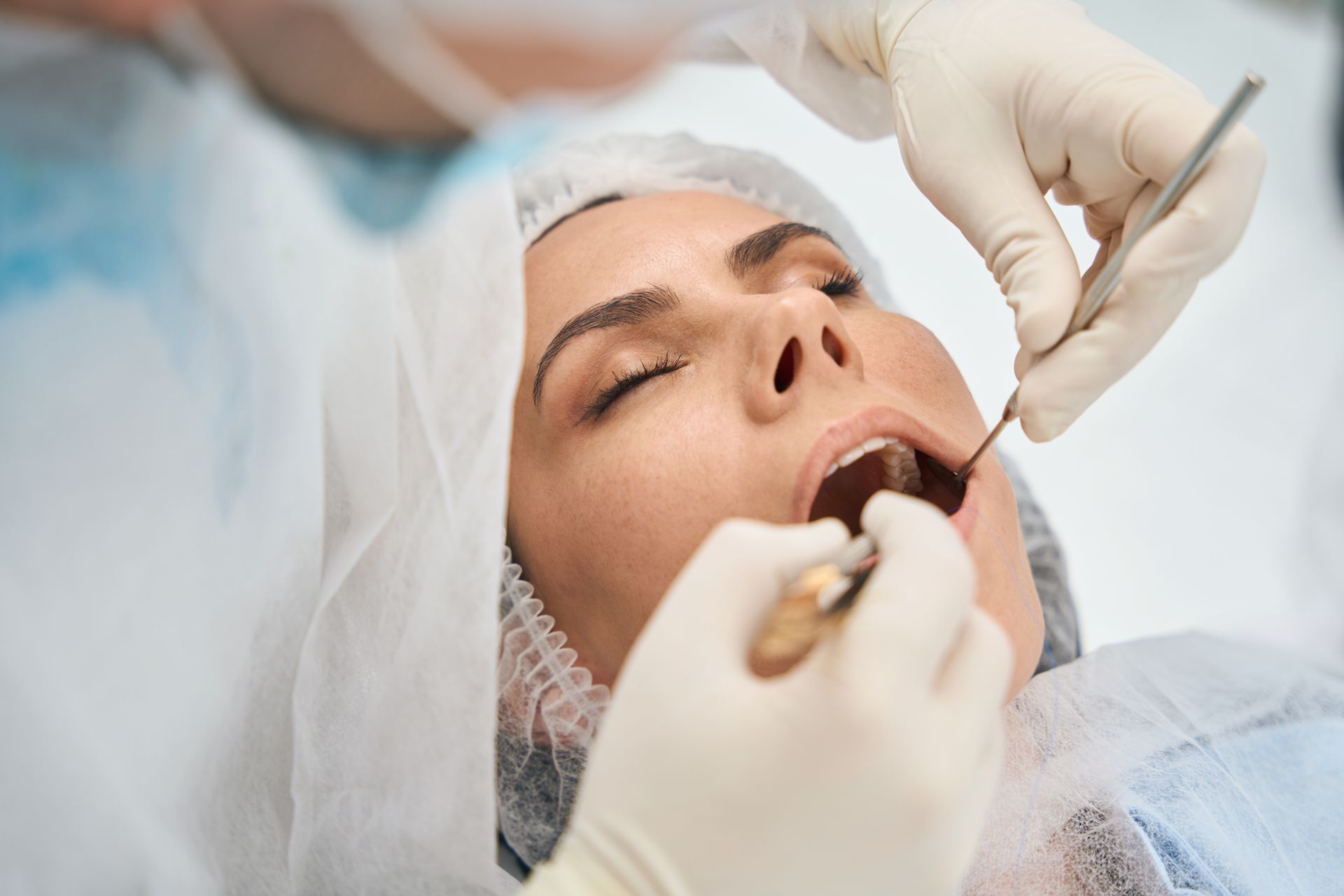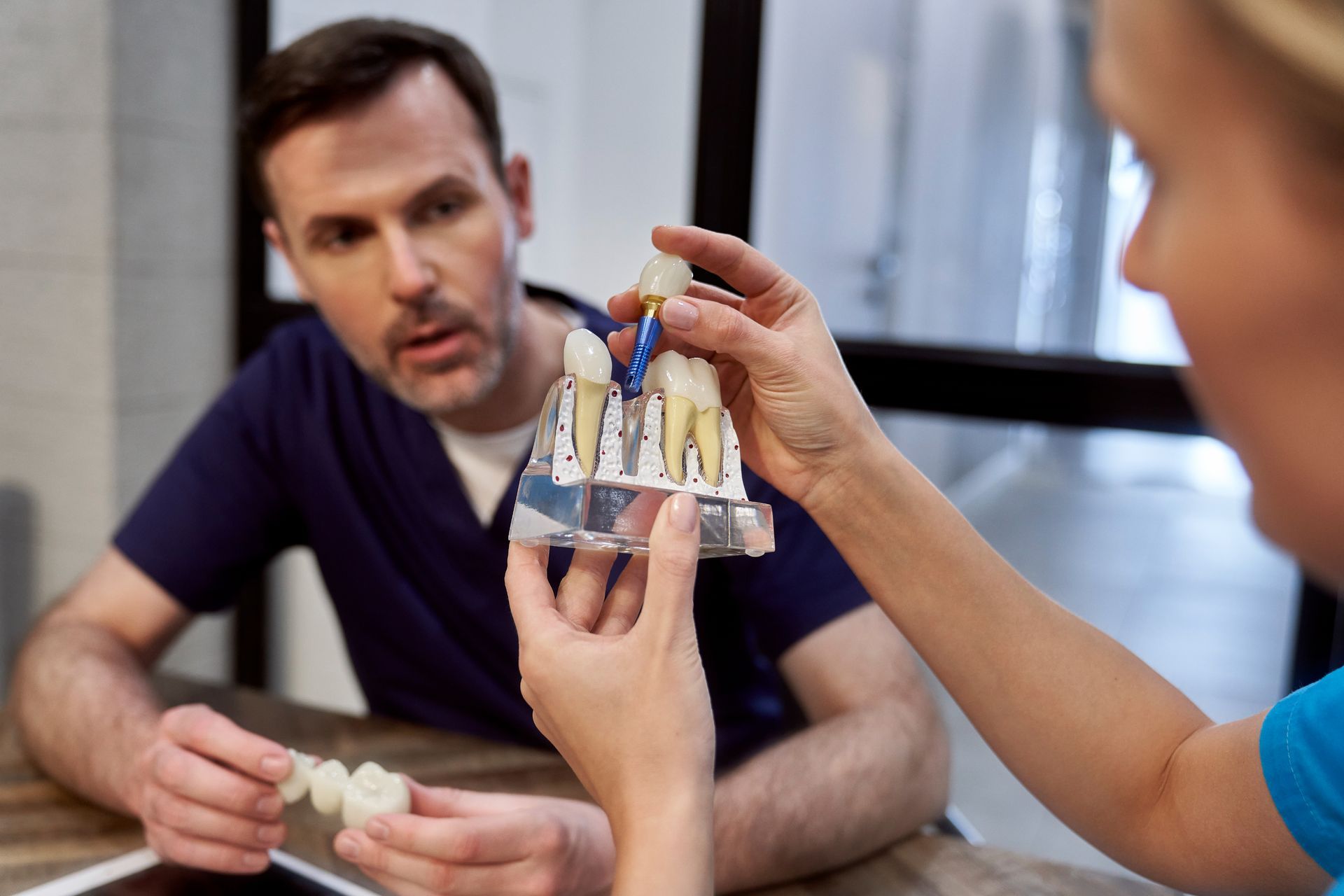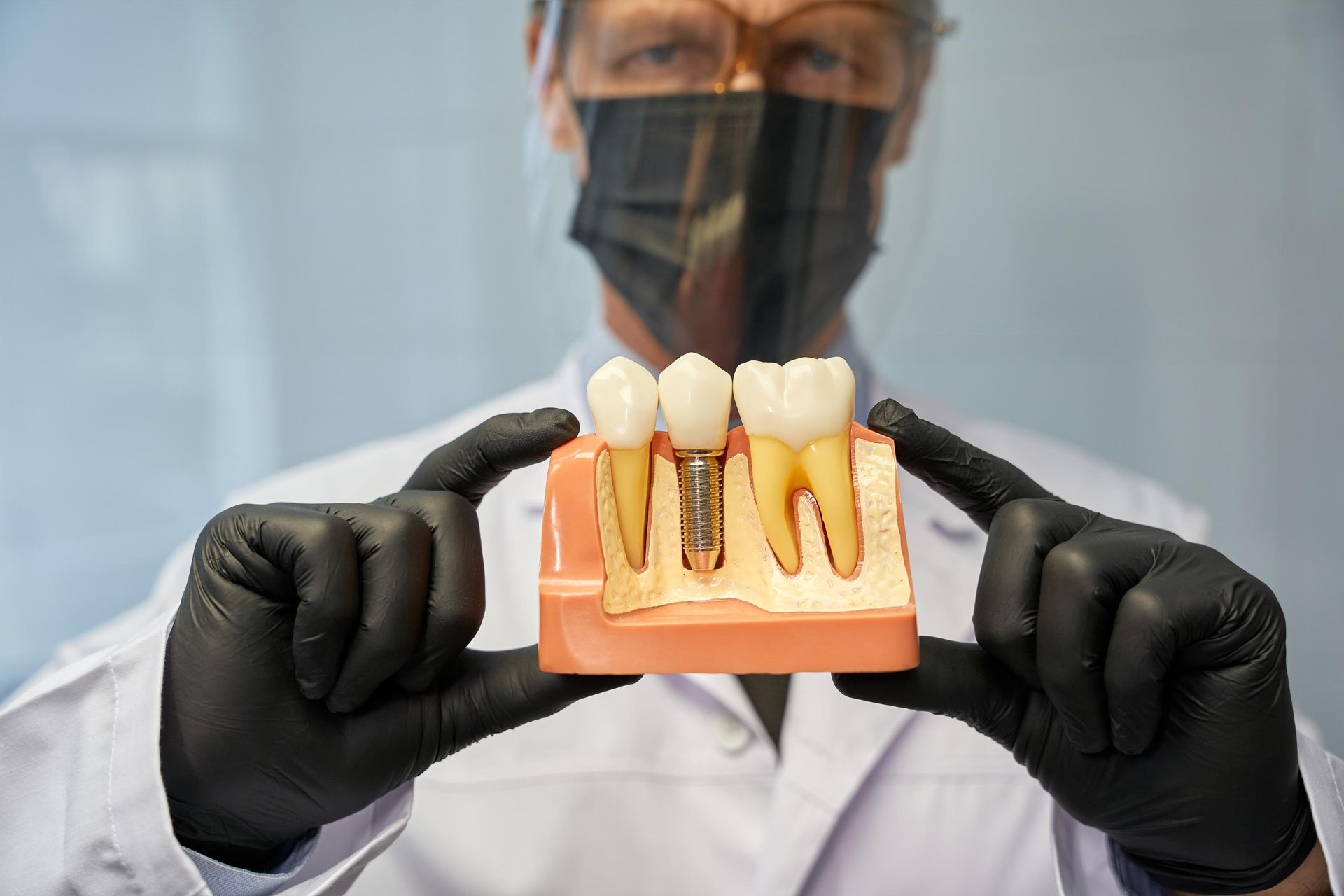Dental Bridge vs Crown: Find the Best Solution for Your Smile
Wondering whether a dental bridge vs crown is right for you? In this article, we’ll break down the key differences and benefits of each, helping you decide the best solution for your dental needs.
Key Takeaways
- Dental crowns are utilized to restore teeth that are damaged or decayed, providing both protection and aesthetic enhancement. In contrast, dental bridges are employed to replace missing teeth by connecting artificial teeth to adjacent natural teeth.
- The treatment process for both crowns and bridges involves reshaping existing teeth and taking impressions for precise fit, with a temporary restoration in place during the waiting period for the permanent solution.
- Choosing between crowns and bridges depends on factors such as the type of tooth damage, overall dental health, budget, and aesthetic preferences, with crowns being better for individual tooth issues and bridges for multiple missing teeth.
Understanding Dental Crowns
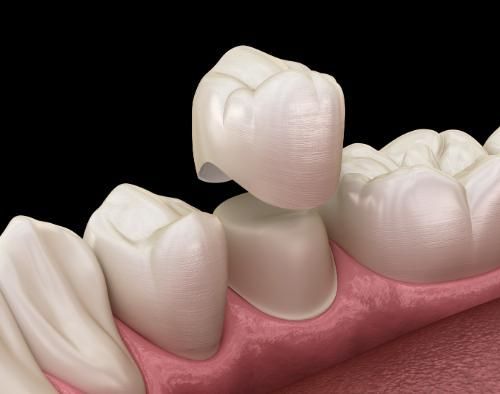
A dental crown is essentially a cap placed over a damaged or decayed existing tooth to restore its shape, size, strength, and appearance.
Dental crowns are used to:
- Protect weak teeth from breaking
- Hold together parts of a cracked tooth
- Support teeth with large fillings when there isn’t much tooth left
- Cover dental implants
This makes them versatile in restorative dentistry.
Various materials are used to craft dental crowns, including gold alloy, metal alloys, porcelain, acrylic, and ceramics. Porcelain, acrylic, and ceramics are particularly popular because they mimic the appearance of natural teeth, enhancing the aesthetics of your smile. The choice of material depends on the specific needs of the patient, including the location of the tooth and the desired durability and appearance.
Exploring Dental Bridges
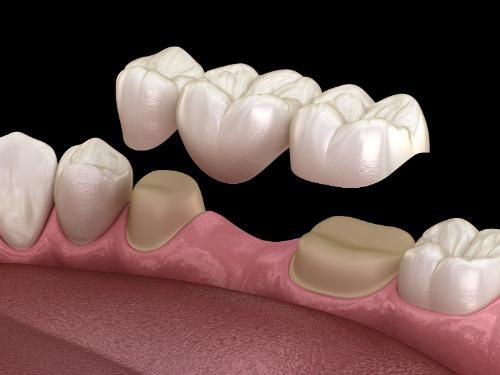
Dental bridges are designed to replace one or more missing teeth by bridging the gap with artificial teeth held in place by adjacent existing teeth. A typical dental bridge consists of two crowns on the teeth on either side of the gap and false teeth, known as a pontic, in between. This structure ensures that the bridge is stable and functional, restoring your ability to chew and speak properly.
There are different types of dental bridges, such as traditional bridges, which use two crowns and a pontic; cantilever bridges, which use only one adjacent tooth as an anchor; Maryland bridges, which use a metal or porcelain framework instead of crowns; and implant-supported bridges, which are anchored by dental implants rather than adjacent teeth.
Common materials for dental bridges include porcelain and metal frameworks, providing a durable and aesthetically pleasing solution for missing teeth.
When to Choose a Dental Crown

Choosing a dental crown is often the best option when you have a damaged or decayed tooth that needs protection. Crowns are particularly useful for teeth that are weak or cracked, as they can hold the tooth together and prevent further damage. They are also recommended for restoring teeth that are already broken or significantly worn down, providing a strong and durable solution.
Dental crowns are also used to support teeth with large fillings when there is minimal tooth structure remaining. This ensures that the tooth remains functional and protected. In many cases, crowns are chosen for their ability to enhance the appearance of misshapen or discolored teeth, making them a versatile option in restorative and cosmetic dentistry.
When to Opt for a Dental Bridge
Dental bridges are particularly effective for restoring gaps created by missing teeth, ensuring that remaining teeth do not shift out of position. Gaps from missing teeth can lead to various issues, including bad bite, gum disease, and TMJ disorders, so dental bridge fills promptly is essential.
Bridges are a suitable option for replacing multiple missing teeth, provided there are strong adjacent teeth to support the bridge. One of the advantages of dental bridges is that they can be quickly implemented, often requiring only two visits to the dentist for fitting. This makes them a convenient and effective solution to replace missing teeth for many patients.
Comparing Costs: Crowns vs. Bridges
The financial aspect of dental restoration is an important consideration. Generally, dental bridges tend to be more expensive than crowns due to the additional materials and the complexity of the procedure. The typical cost range for a dental crown is between $800 to $1,500 per tooth, while dental bridges usually range from $500 to $1,200 per tooth.
The costs of dental crowns and bridges can vary based on several factors, including the materials used, the complexity of the procedure, geographical location, and insurance coverage. Many dental practices offer payment plans, health savings accounts (HSA), and flexible spending accounts (FSA) to help manage these costs. Consulting with your dentist about all available options can help you make the best financial decision.
The Treatment Process for Crowns and Bridges
The treatment process for both dental crowns and bridges begins with the dentist removing any decay and reshaping the tooth to ensure a proper fit. An impression of the prepared tooth is then made using a wax bite or digital scanner, which allows for a precise fit of the final restoration.
While waiting for the permanent crown or bridge, a temporary one is placed to protect the tooth. Once the permanent restoration is ready, the dentist will cement it in place after making any necessary adjustments to ensure a perfect fit. This process, although meticulous, ensures a long-lasting and functional result.
Longevity and Maintenance of Crowns and Bridges
Dental crowns and bridges generally have a lifespan of 5 to 15 years, but with proper maintenance, they can last even longer. The longevity of these restorations depends on various factors, including the materials used and how well they are maintained. For example, porcelain crowns offer a natural appearance but may be more prone to chipping compared to metal crowns.
Diet and oral hygiene play critical roles in the lifespan of dental treatment restorations. A high intake of sugary or acidic foods can contribute to tooth decay, while effective oral health practices, including regular brushing and flossing, are essential for preventing issues that can affect crowns and bridges.
Regular dental check-ups can also help extend their lifespan significantly.
Using Dental Implants with Crowns and Bridges
Dental implants can provide a stable foundation for both crowns and bridges, making them an excellent option for restoring missing teeth. Unlike traditional bridges, implants help maintain jawbone density and prevent bone resorption around the pontics of a bridge.
The process of placing dental implants involves a surgical procedure in which the implant is positioned into the jawbone, followed by the attachment of crowns or bridges.This method offers greater strength and stability compared to traditional options and does not require reshaping of surrounding teeth, preserving their healthy structure.
Home Care Tips for Crowns and Bridges
Maintaining good oral hygiene is crucial for the longevity of crowns and bridges. This includes daily brushing and flossing around the restorations to prevent plaque buildup and decay. For bridges, using a floss threader or a water flosser can be particularly effective in cleaning around the dental restoration.
Additionally, wearing a night guard can help protect crowns and bridges from wear caused by teeth grinding. Regular dental check-ups are crucial for monitoring the condition of your restorations and promptly addressing any potential issues.
Materials Used in Crowns and Bridges
Common materials used for dental crowns include gold, silver, metal alloys, porcelain, and zirconia. Each material has its advantages: metal crowns are known for their durability and compatibility with natural teeth, while porcelain-fused-to-metal crowns can sometimes exhibit a dark line at the gum line and are more prone to chipping.
Dental bridges are often made from similar materials, with porcelain and metal frameworks being the most common due to their durability and aesthetic appeal. Ceramic crowns are often preferred for their natural appearance, making them a popular choice for visible teeth.
Choosing the Right Dental Restoration for You
Choosing between a crown and a bridge depends on various factors, including the location and type of tooth damage, overall dental health, and personal preferences. Crowns are often beneficial for cosmetic enhancements, particularly for misshapen or discolored teeth, while bridges reinforce and protect partially damaged teeth.
Budget and aesthetic concerns also play a crucial role in this decision. Dental bridges require adjacent teeth to be altered, which may affect their health and strength over time. It's crucial to steer clear of sticky or hard foods to avoid causing damage to crowns and bridges.
Summary
In conclusion, dental crowns and bridges offer effective solutions for restoring damaged or missing teeth. Both options have their unique advantages and considerations, from cost and materials to treatment processes and longevity. By understanding these factors, you can make an informed decision that best suits your dental needs and maintains your beautiful smile.
Frequently Asked Questions
Orlando Lifestyle Dentistry
What is the main difference between a dental crown and a dental bridge?
The main difference between a dental crown and a dental bridge is that a crown is used to cover and restore a damaged tooth, whereas a bridge is specifically designed to replace missing teeth by using adjacent teeth for support.
How long do dental crowns and bridges last?
With proper care, dental crowns and bridges typically last between 5 to 15 years, and sometimes even longer. Maintaining good oral hygiene is crucial for prolonging their lifespan. It is essential to maintain good oral hygiene to extend their lifespan.
Are dental implants better than traditional crowns and bridges?
Dental implants generally offer superior strength, stability, and help maintain jawbone density, making them a more advantageous long-term solution compared to traditional crowns and bridges, despite the longer treatment time and surgical requirements.
What materials are used for dental crowns and bridges?
Dental crowns and bridges are commonly made from materials such as gold, silver, metal alloys, porcelain, zirconia, and resin, each offering unique benefits regarding durability and aesthetics. Selecting the appropriate material is essential for achieving long-lasting and visually appealing results.
How do I maintain my dental crowns and bridges?
To ensure the longevity of your dental crowns and bridges, it is essential to maintain good oral hygiene through regular brushing and flossing, use a night guard if needed, and attend routine dental check-ups. This proactive approach will help preserve your dental work effectively.
